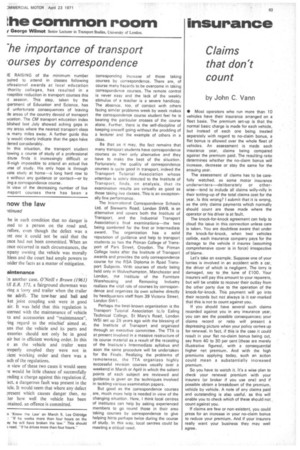know the law
Page 64

Page 65

If you've noticed an error in this article please click here to report it so we can fix it.
by Les Oldridge AIRTE, AMIMI
Dangerous vehicles and loads (1)
ONE of the most important parts of the Motor Vehicle (Construction and Use) Regulations 1969, is Regulation 76 (i) which deals with the maintenance and use of vehicles so that they are not dangerous.
This regulation deals with both motor vehicles and trailers and all parts and accessories with which they are fitted, and covers the number of passengers carried by the vehicle and the way in which they are carried. Goods vehicles also come within its scope as the weight, distribution, packing and adjustment of loads are particularly mentioned.
The regulation is only concerned with preventing danger; for the offence to be complete then danger must be caused, or be likely to be caused, to a person in or on the vehicle or trailer or on the road. Defects in the vehicle which are not dangerous, for example peeling paint or a leaking cab roof, are not an offence.
It is not necessary for the prosecution to prove actual danger, potential danger is sufficent for a conviction to be recorded. For example, if, because the wheel nuts are not properly tightened, a wheel comes off a lorry on a road with no other vehicle in sight and without any harm befalling the driver then an offence has been committed because danger was "likely to .be caused". Another vehicle might have been passing the offending lorry when the wheel came off and a collision could have occurred.
Defects concerning brakes, steering gear and tyres are specifically dealt with in other parts of the Regulations. Regulation 76 is used by the police when they prosecute for any other dangerous defect not covered in this way. One can think of many instances where this type of offence could be committed. The cracked chassis, broken spring hanger, torn wing, loose wheel nui and fractured spring leaf are obvious cast of this kind. In each prosecution, howeve actual or potential danger must be proved.
In the case of the torn wing, for exampt danger would be caused if the jagged edg of the wing protruded so as to be likely t injure a passing pedestrian.
That part of the Regulation which dea with "weight, packing, distribution an adjustment of the load" is not often used. goods vehicles are overweight there at other regulations which deal with tt offence and insecure loads are covered i the second part of Regulation 76, which will discuss later. One can visuali2 circumstances where an offence against thN part of the Regulation dealing with ti carriage of passengers could be committel A flat platform truck used to carry childre where there was a risk of them falling off a fully laden minibus with addition passengers lying on the roof are tv examples which come readily to mind. TI latter incident has, incidently, actual happened.
In F. Austin (Leyton) v East 1961, Crh L.R. 119 an articulated lorry was beit used when, owing to a defect in the lockii mechanism of the fifth-wheel, tl semi-trailer became detached, as a result which danger was caused to persons on ti road. It was agreed that there was t evidence that the vehicle had not beg properly maintained and that some late defect in the locking mechanism had causl the accident. It was held that this regulatit is absolute in its terms and was directed the vehicle. The regulation imposes ; obligation that the vehicle at all times, th is to say at any moment of the journey. h
be in such condition that no danger is tsed to a person on the road and, Tefore. even though the defect was a :s.nt one it could not be said that the once had not been committed. When an once occurred in such circumstances, the npany owning the vehicle was morally Riess and the court had ample powers to isider the facts as a matter of mitigation.
aintenance
In another case, O'Neill v Brown (1961) III E.R. 571, a fairground showman was ving a lorry and trailer when the trailer me adrift. The tow-bar and ball and :ket joint coupling unit were in good air. It was held that this regulation is icerned with the maintenance of vehicle ts and accessories and "maintenance", /ing regard to the mischief aimed at, ans that the vehicle and its parts and essories should not only be in good air but in efficient working order. In this e as the vehicle and trailer were woperly coupled they were not in oient working order and there was a ach of the regulations.
it view of these two cases it would seem re would be little chance of successfully :tiding a charge against this regulation if, 'act, a dangerous fault was present in the ice. It would seem that where any defect present which causes danger then, no tter how well the vehicle has been intained. an offence is committed.




























































































































